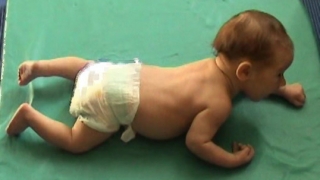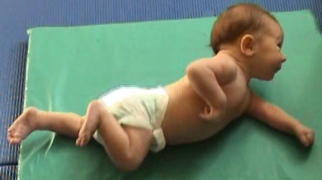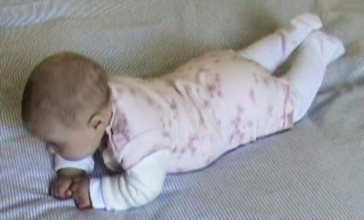In this post I review the development of control of weight distribution, trunk extension and lower limb action in the prone position over the first 7 months.
In typically developing infant changes in the control of trunk extension and associated shift of weight towards the pelvis, along with positioning and movement of the the lower limbs develops over the first 7 months.


In infants with atypical development this trajectory is often hampered by low levels of activity, muscle weakness (and poor muscle tone) and issues with range of movement.

Typical development in prone
Newborn
Hips flexed with some abduction, knees flexed and ankles in dorsiflexion
Anterior pelvic tilt with weight over the upper chest

2 weeks old
Posterior pelvic tilt, weigh over upper chest
Hips flexed flexed with some abduction, knees full flexion, ankles dorsiflexed

Will prone at 5 weeks
At 5 weeks Will engages in active kicking actions. These are associated with most of his weight being carried over his upper chest, as well as active extension of the thoracic spine which allows him to lift his head.



This sequence of frames nicely illustrates how weight distribution moves in a caudal direction when Will decides to initiate rolling onto his back by lifting up his head.


Prone at 12 weeks
Weight over the abdomen and pelvis with some trunk extension
Hips in some flexion, abduction and external rotation with knee flexion and ankle in dorsiflexion.

Kicking movements of the lower are associated with increased trunk extension


Will at 14 weeks
Strong activation of the spine extensors stabilize the trunk for bilateral kicking.
When flexed, the hips are abducted with external rotation. Hip extension is associated with adduction to 0 degrees.


Will at 18 weeks


Will at 5 months
Strong extension of the spine, lifting the chest and thighs.

Weight shifted onto the pelvis. Good trunk extension allows for effective weight bearing on the upper limbs.


Will at 6 months




Will at 8 months
At 8 months Will is very mobile in prone. This mobility is supported by his ability to extend his spine.


Will has learned to shift between trunk extension and trunk flexion as he pushes up onto his knees.


Notice that as he starts to push up his hips are abducted a few degrees which makes it easy move into prone kneeling.


Atypical development in prone
How does Max and Lily's development differ from the movement patterns observed in a typically developing infant?
What strength and flexibility impairments are hampering thier action?
Max at 8 months


Max at 10 months




Lily at 4 months




|
I would really like some feedback on my analysis. Please use the comment box to let me (and other people reading this post) what you think and what should be changed or added. |
For subscribers Subscribe here
More about development in prone - videos and analysis
SF-TO Movement Therapy Guidelines: Prone
Comments
Thank you Pam for the wonderful post. now coming to the feedback on question asked by you
1. Max and lily are differring from their expected trajectory are as - poor activation of spinal extensor muscles and weight bearing this leads to excessive abduction of lower limbs with more anterior pelvic tilting creates restriction on weight bearing on upper extremities precisely on shoulder girdles. Also in max shows excessive plantaflexion and inversion in feet which furthermore reduces the momentum and inadequate generation of force to crawl and kneel walking (this analysis is when max at 8 months)
When max at 10 months(4th image) max still prefers the upper extremities for weight bearing and with this help he succeeded to get elevation which clearly shows poor spinal extensors weakness. Max still prefers prone with broad/wide abduction, excessive hip extension.